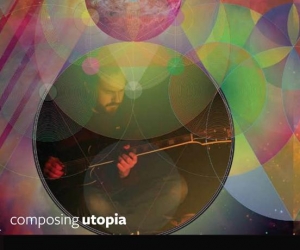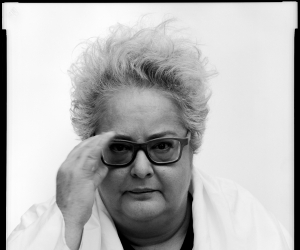
The prospects are grim for a person who has fallen into a black hole. The gravitational forces exerted by these mysterious regions of space are so strong that nothing—not even light—can escape, once it passes a certain proximity threshold. From a safe distance, the unlucky soul would appear to stretch and smear as it approached the void. It would move more and more slowly and eventually just freeze, taking an eternity to be enshrouded by darkness. Time would tick away normally until it was torn apart (“spaghettified,” technically speaking) and then crushed into oblivion.
“Darkness may say nothing, as all captured sound, matter, and light get compressed to a single point,” says Russian-born, Berlin-based artist, techno producer, and DJ Dasha Rush, who tests this hypothesis with 110dB and 52,000 lumens in Dark Hearts of Space, her latest audiovisual performance piece, which premiered at the seventeenth edition of Mutek in Montreal in June 2016. “It’s a journey into a black hole, where the point of culmination would be achieving singularity,” she says, describing the piece’s narrative arc. Extending the atmospheric and dreamy sound design of her 2015 conceptual album Sleepstep—Sonar Poems for My Sleepless Friends (Raster-Noton), and calling on the CG prowess of her Russian compatriot Stanislav Glasov, Rush started the collaborative project with a simple question: “How would I visualize silence?”
As if inspired by the storied tagline for the classic 1979 sci-fi film Alien—“In space, no one can hear you scream”—Rush gravitates towards silence at a galactic scale. Dark Hearts of Space represents cosmic churn on a pair of surfaces. A transparent scrim sits centre stage, several metres in front of a rear projection screen. To create the illusion of depth, layered projections, strobe lights, and smoke render the imposing void as a hovering volumetric form. Starting with a consideration from afar, then approaching and breaching the event horizon, Rush and Glasov propel the audience into the darkness, with the former programming spartan tones and textures, using Reaktor software and an Ableton Live kit, while her copilot analyzes the frequencies and triggers a choreography of eddying forces, using the visual programming language TouchDesigner.
Rush and Glasov spent two weeks prototyping Dark Hearts of Space this past winter at The Banff Centre’s inaugural Convergence Residency. A joint venture with Mutek, the residency cultivates multidisciplinary projects that occupy the grey area between electronic music and visual art. “It was filled with people who were almost all autodidacts, inventors, and experimenters—mavericks really—all working in forms that have no road maps,” says Convergence artistic director and longtime Mutek programmer Patti Schmidt, when asked about the residency’s first cohort of artists.
When applied to Dark Hearts of Space, Schmidt’s comment about forms with no roadmaps seems fitting. After all, a deep listening journey inside a black hole could only ever be an unchartable one-way trip.
Image courtesy of Dasha Rush.


